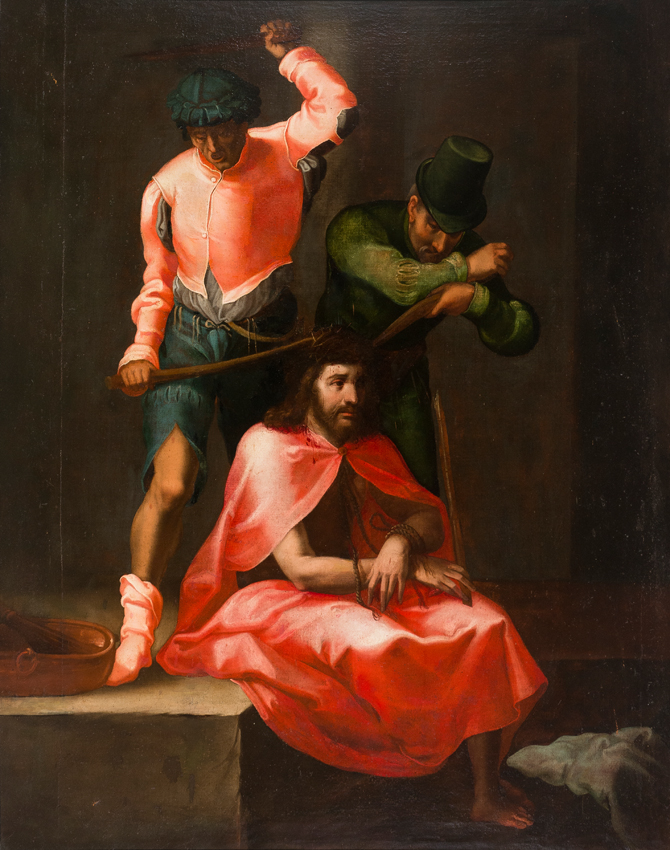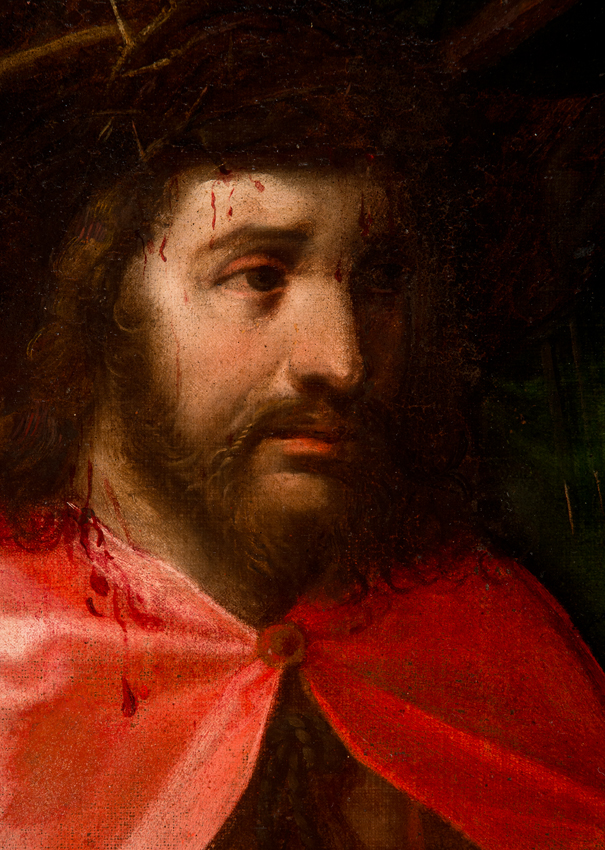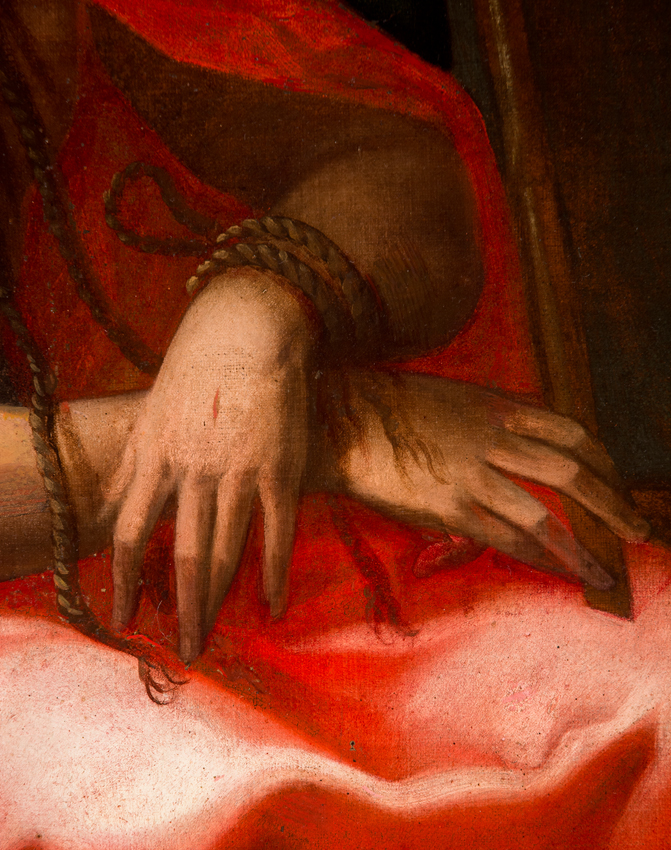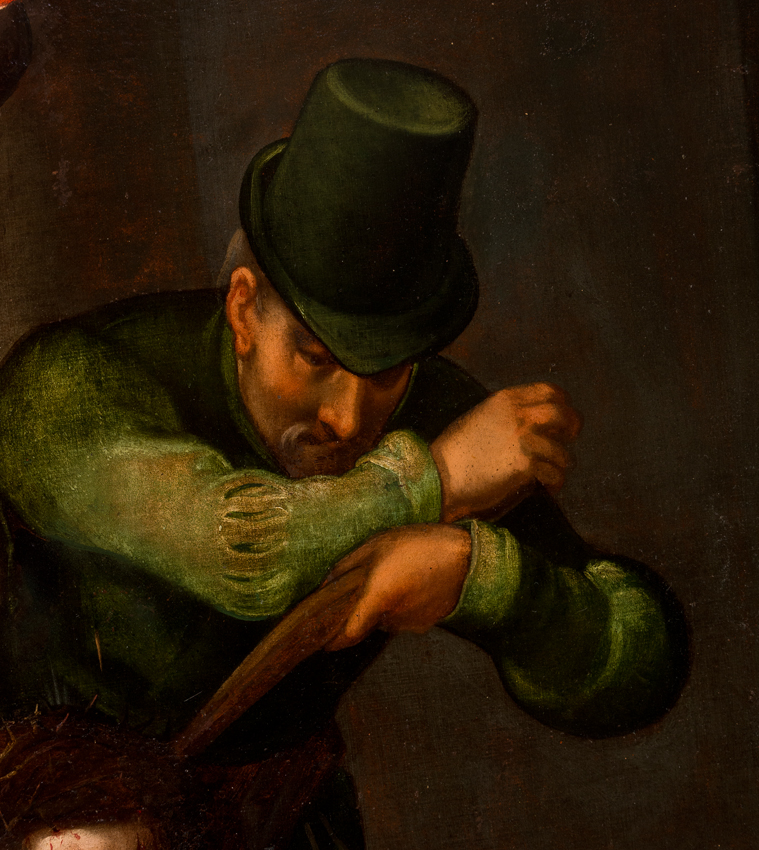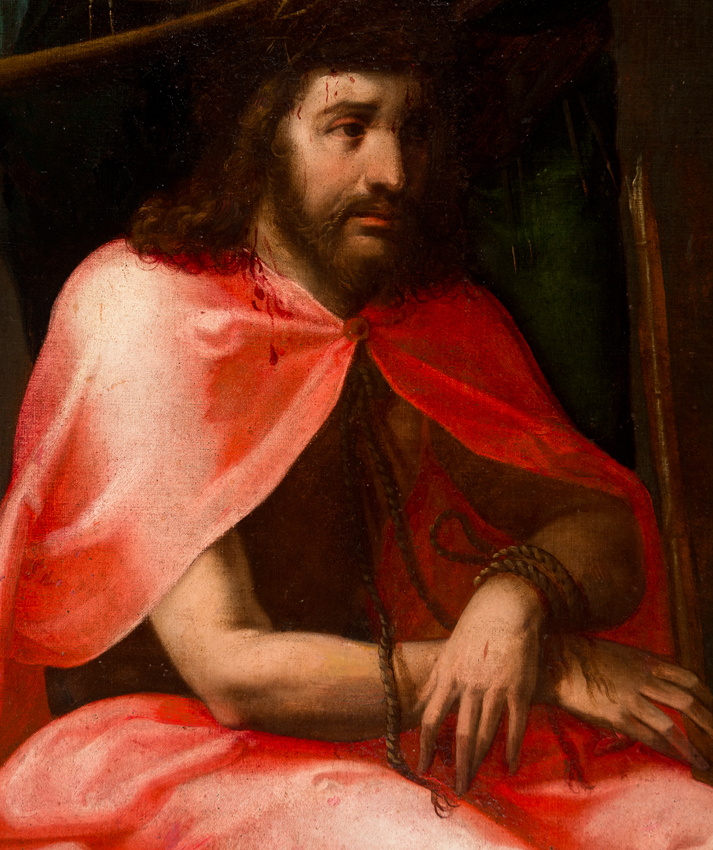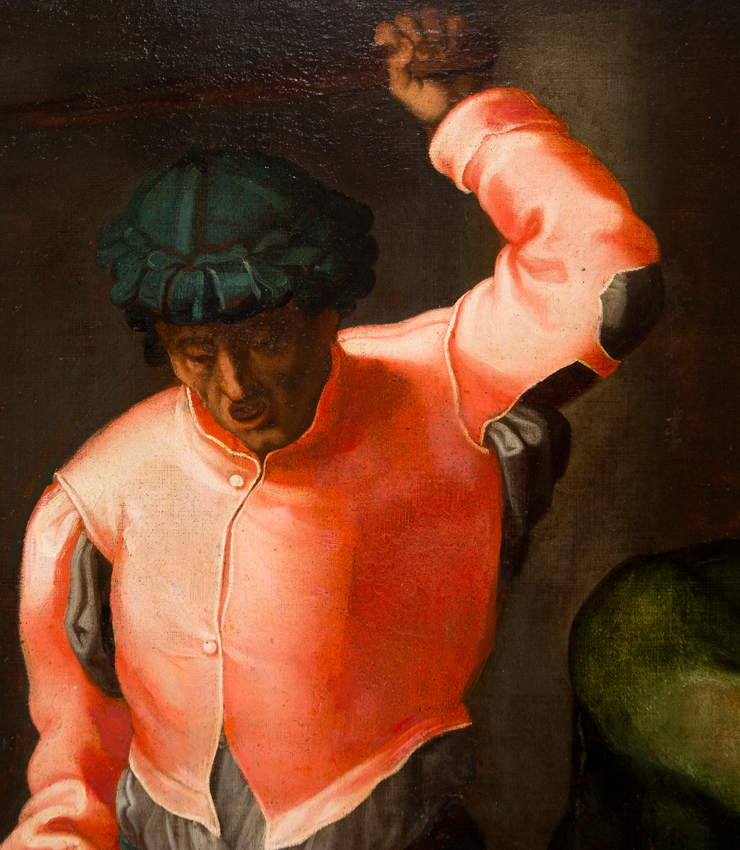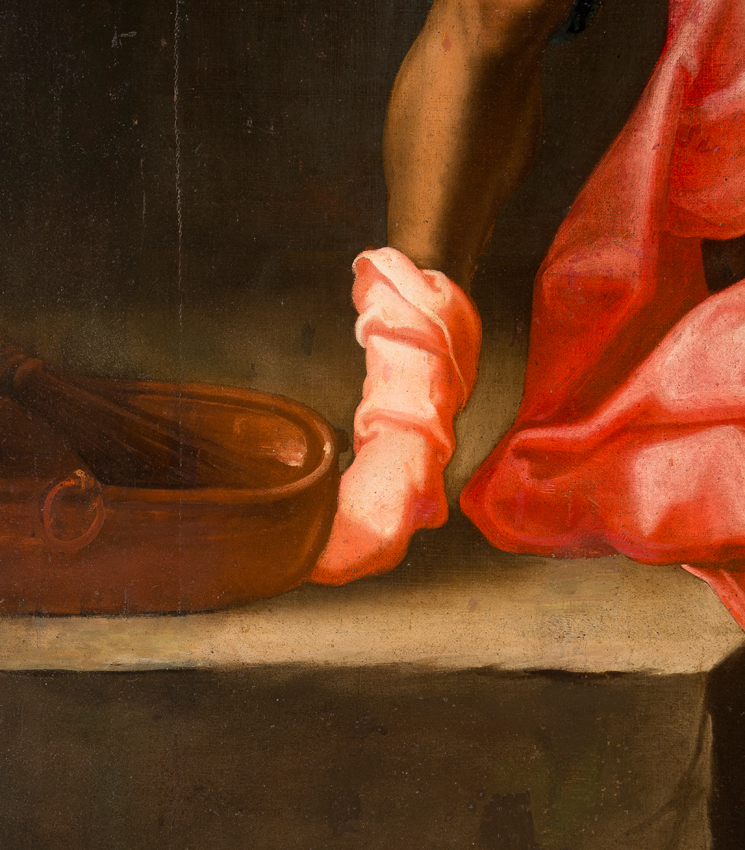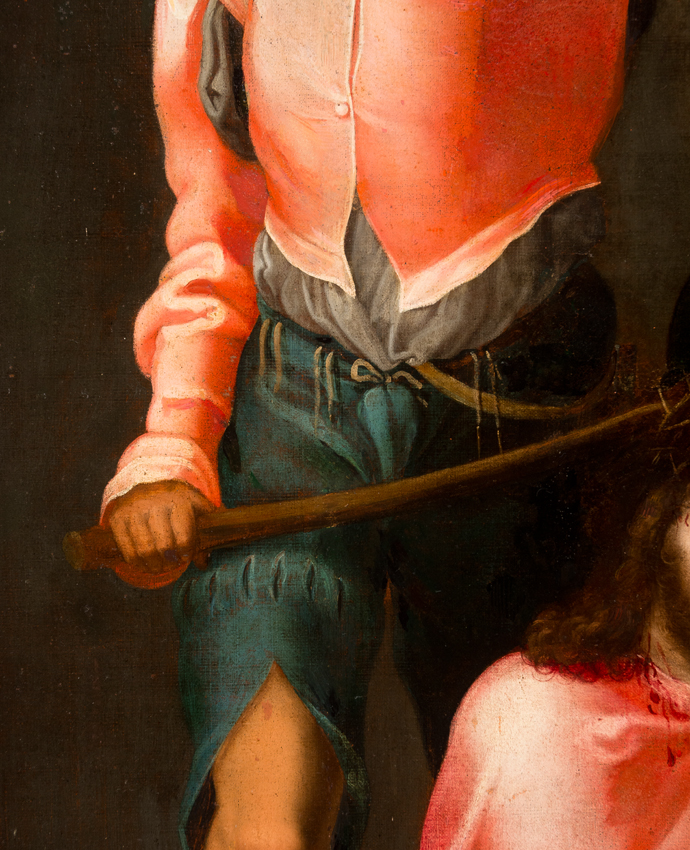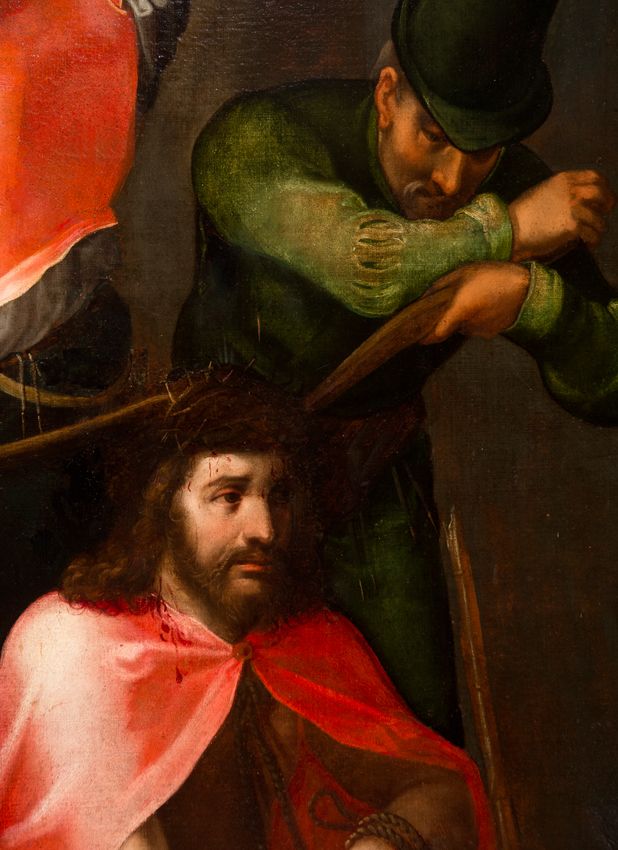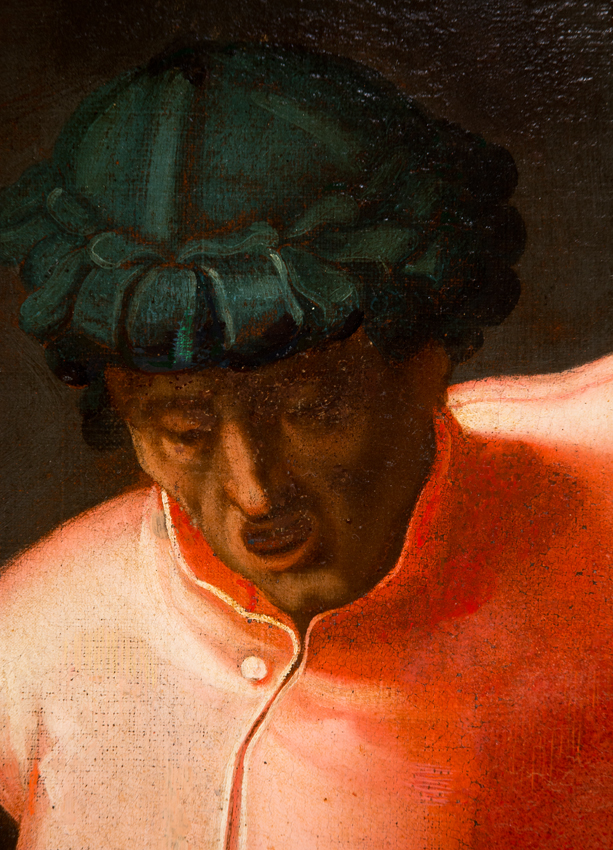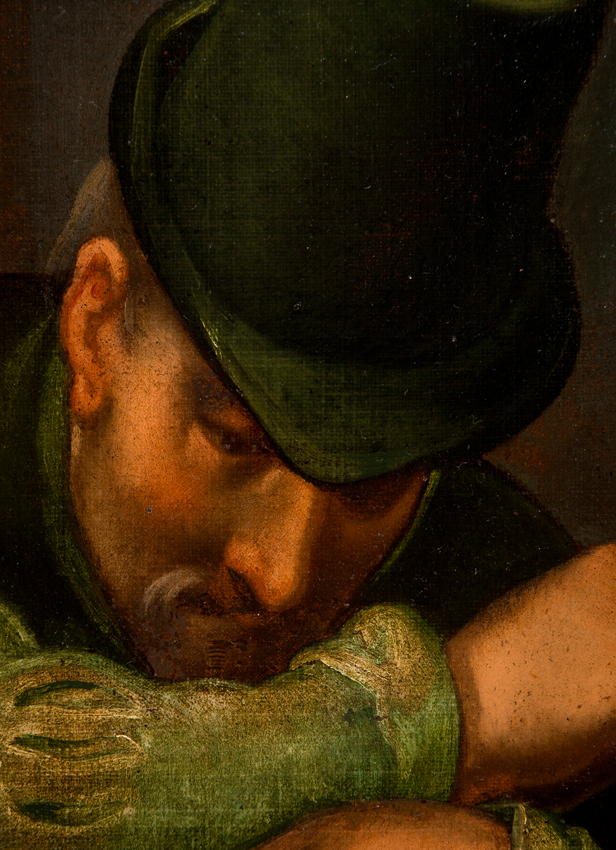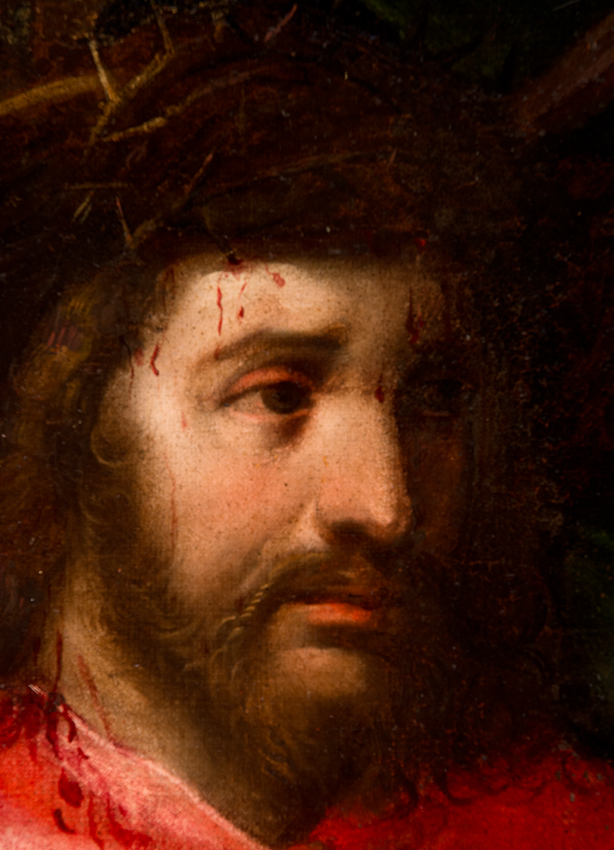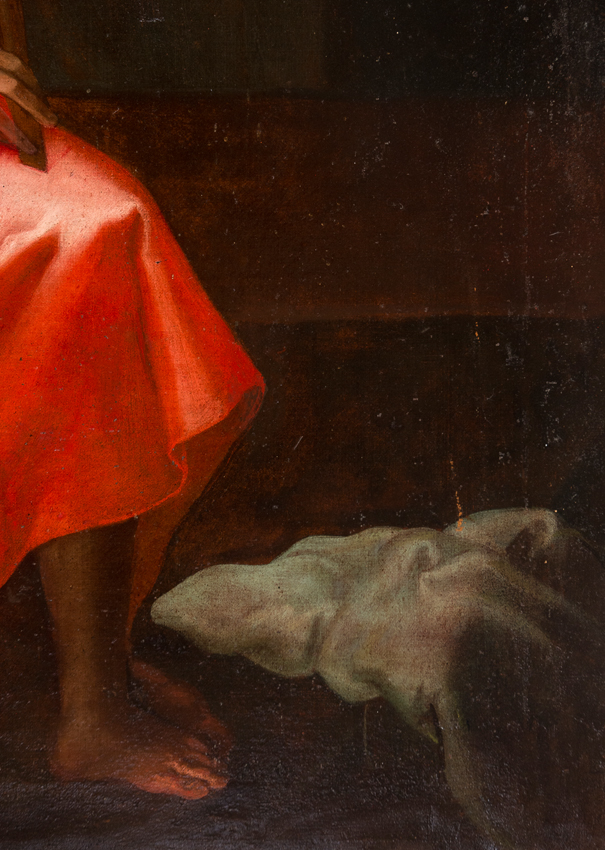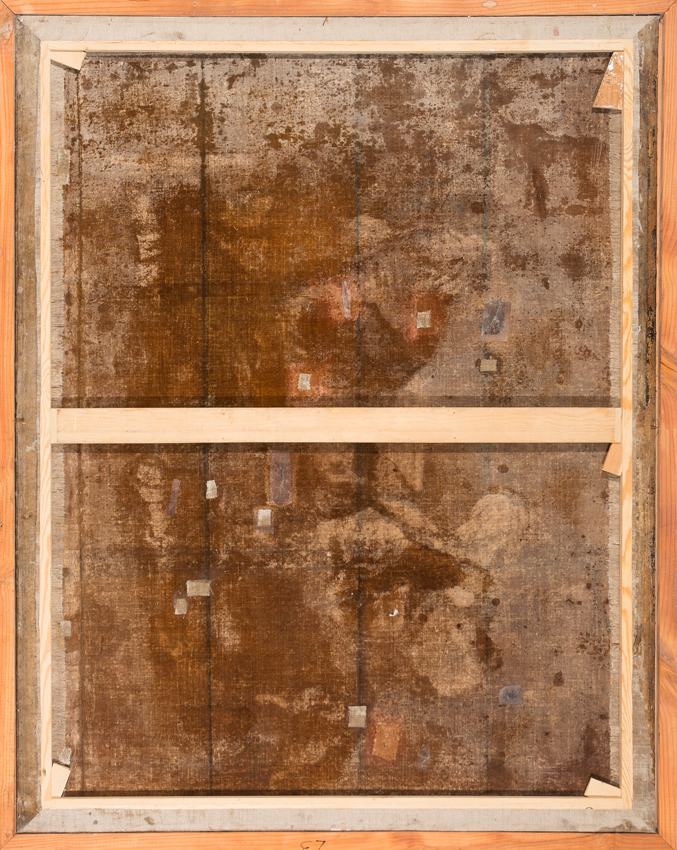25
Italian School . Early 17th century
"The Crowning with Thorns"
Oil on canvas. 142 x 110 cm.
After the flagellation ordered by Pontius Pilate, Jesus was tortured and mocked by the executioners and soldiers, who put a crown of thorns on his head to accredit Him, sarcastically, as the King of the Jews: “Then the governor’s soldiers took Jesus into the Praetorium and gathered the whole company of soldiers around him. They stripped him and put a scarlet robe on him, and then twisted together a crown of thorns and set it on his head. They put a staff in his right hand. Then they knelt in front of him and mocked him. “Hail, king of the Jews!” they said. They spit on him, and took the staff and struck him on the head again and again. After they had mocked him, they took off the robe and put his own clothes on him. Then they led him away to crucify him” (Matthew 27: 27-31).
All the elements and actions narrated in the cited extract are those which appear in this superb painting, probably created in Italy, and which faithfully copies an engraving made in 1597 by Hendrick Goltzius (1558-1617), although in a more reduced version, considering that in the aforementioned print we see Christ situated before the steps of the praetorium, mocked by numerous people who are both standing and kneeling, besides others – one of whom could be Pilate himself – who observe the scene impassively from the praetorium. The anonymous painter of this picture, which is of exquisite style and quality, has focussed his creation on just three characters who have acquired greater monumentality that those in Goltzius’ engraving.
The scene takes place in a sombre atmosphere lit only by an exterior beam of light which emanates from the left side. This is tenebrist illumination and is a distant reminder of the results obtained by Caravaggio (1571-1610) and his followers. This containment of the light contrasts vividly with the gesture and dynamism of one of the executioners, who appears to be engaged in beating Christ impetuously with the stick he holds in his left hand. At the same time, in his right hand he holds an element with which he braids the crown of thorns on the Lord’s head, along with his colleague. At the feet of this executioner, who is dressed in trousers hacked off to the mid-thigh, is a recipient which contains part of the set of tools with which this new torture of Christ is being carried out. The other executioner, dressed in clothes in different gradations of green which contrast with the reds of the other two characters, has a calmer and more passive attitude in the scene.
Christ is seated on a stone step. He has his hands tied and is holding the staff with an expression on his face which is between relaxed and resigned. His calm attitude contrasts with that of the mocking soldiers who are making the crown of thorns. He wears a crimson tunic with some very rich gradations of colour that form a potent focal point of light, which also occurs with the footwear and smock of the executioner who is attacking him. The clothes that both executioners are wearing are those worn by men in the period that this canvas was painted, meaning the early 17th century.
The painting is outstanding, not just because of its extremely rich colouring, in which the vivid reds contrast with the greens and blues, but also because of the careful drawing with which it has been conceived and the brushwork with which it has been carried out. It is difficult to establish an identity for the painter, but it could be from an Italian workshop, although without being able to specify a School, the most illustrious at the time were the Roman, Bolognese and Tuscan-Florentine Schools.
We would like to thank Javier Baladrón, doctor in History of Art, for cataloguing this piece.
"The Crowning with Thorns"
Oil on canvas. 142 x 110 cm.
After the flagellation ordered by Pontius Pilate, Jesus was tortured and mocked by the executioners and soldiers, who put a crown of thorns on his head to accredit Him, sarcastically, as the King of the Jews: “Then the governor’s soldiers took Jesus into the Praetorium and gathered the whole company of soldiers around him. They stripped him and put a scarlet robe on him, and then twisted together a crown of thorns and set it on his head. They put a staff in his right hand. Then they knelt in front of him and mocked him. “Hail, king of the Jews!” they said. They spit on him, and took the staff and struck him on the head again and again. After they had mocked him, they took off the robe and put his own clothes on him. Then they led him away to crucify him” (Matthew 27: 27-31).
All the elements and actions narrated in the cited extract are those which appear in this superb painting, probably created in Italy, and which faithfully copies an engraving made in 1597 by Hendrick Goltzius (1558-1617), although in a more reduced version, considering that in the aforementioned print we see Christ situated before the steps of the praetorium, mocked by numerous people who are both standing and kneeling, besides others – one of whom could be Pilate himself – who observe the scene impassively from the praetorium. The anonymous painter of this picture, which is of exquisite style and quality, has focussed his creation on just three characters who have acquired greater monumentality that those in Goltzius’ engraving.
The scene takes place in a sombre atmosphere lit only by an exterior beam of light which emanates from the left side. This is tenebrist illumination and is a distant reminder of the results obtained by Caravaggio (1571-1610) and his followers. This containment of the light contrasts vividly with the gesture and dynamism of one of the executioners, who appears to be engaged in beating Christ impetuously with the stick he holds in his left hand. At the same time, in his right hand he holds an element with which he braids the crown of thorns on the Lord’s head, along with his colleague. At the feet of this executioner, who is dressed in trousers hacked off to the mid-thigh, is a recipient which contains part of the set of tools with which this new torture of Christ is being carried out. The other executioner, dressed in clothes in different gradations of green which contrast with the reds of the other two characters, has a calmer and more passive attitude in the scene.
Christ is seated on a stone step. He has his hands tied and is holding the staff with an expression on his face which is between relaxed and resigned. His calm attitude contrasts with that of the mocking soldiers who are making the crown of thorns. He wears a crimson tunic with some very rich gradations of colour that form a potent focal point of light, which also occurs with the footwear and smock of the executioner who is attacking him. The clothes that both executioners are wearing are those worn by men in the period that this canvas was painted, meaning the early 17th century.
The painting is outstanding, not just because of its extremely rich colouring, in which the vivid reds contrast with the greens and blues, but also because of the careful drawing with which it has been conceived and the brushwork with which it has been carried out. It is difficult to establish an identity for the painter, but it could be from an Italian workshop, although without being able to specify a School, the most illustrious at the time were the Roman, Bolognese and Tuscan-Florentine Schools.
We would like to thank Javier Baladrón, doctor in History of Art, for cataloguing this piece.
Images. The Divine and the Human
Sale Date(s)
Venue Address
General delivery information available from the auctioneer
The purchase price includes the delivery of the lots in the venue of the auction. Transporting to other destinations is at the own risk of the client. The customer must contact "LST", to give the corresponding instructions for such transporting. "LST" is not responsible for the packaging or any accident incurred during transportation.
Important Information
Aufgeld / Premium: 22 %
Live: 3 %
jeweils zusätzlich USt. / both plus VAT: 21 %
Terms & Conditions
CONDITIONS OF THE AUCTION:
I. REGISTRATION. To bid in the room customers must register at the beginning, filling out a form and picking a number that will identify them during the auction. Customers may be required to register in bank references or other guarantee system and if they do not prove the solvency "LST" will not accept bids and award the auction.
II. WRITTEN BIDS. "LST" will accept written bids, which will be formalized in the form provided by the room until the day before the auction. In such auctions, the room will bid in name of the client until the maximum stated in the offer and always at the lowest possible price. If there are two or more bids for the same amount, the one placed first will have the priority. Written bids received in advance, will have priority on the day of the auction.
III. TELEPHONE BIDS. "LST" will allow telephone bids, if interested people contact "LST" days before the auction providing personal data, ID card and the phone number which will be used by the staff of "LST" to call at the time of the auction. The buyer, within all the legal rights is making an offer for the asking price, when applies for telephone bid. "LST" will not take responsibility for any technical defects beyond its control, which may prevent to contact successfully the bidder during the auction.
IV. AUCTIONEER. The auction will be conducted by an auctioneer, director of the auction will be judge and arbitrator of it with full authority in its development, will award the lots to the highest bidder and is able to settle any controversy concerning lots sale, reject bids, divide lots or group them and remover objects from the room. Will be able to, if it is deemed suitable, not accept bids on the auction. His decision will be unappealable.
V. SALE OF LOTS. The lots are awarded to the highest bidder. Once the auctioneer blows the hammer, the buyer becomes responsible of the lot purchased, exempting "LST" of liability to for any damage and / or accidents that may occur. No refunds of lots.
VI. STARTING PRICE. The amount shown in the catalogue as the starting price for each lot will be, as a rule, the minimum selling price, except for exceptional cases where a reservation may be agreed upon with the seller or it set discretionary by the room.
VII. SCALE OF BIDS. The bids are set according to the following scale:
From 50.-€ to 200.-€…………………………………………..at 10.-€
From 200.-€ to 500.-€…………………………………… …25 in 25.-€
From 500.-€ to 1.000.-€………………………………..…..….50 in 50.-€
From 1.000.-€ to 2.000.-€………………………………..…100 in 100.-€
From 2.000.-€ to 5.000.-€……………………………….….250 in 250.-€
From 5.000.-€ to 10.000.-€…………………………………500 in 500.-€
From 10.000.-€ to 20.000.-€……………………………1.000 in 1.000.-€
From 20.000.-€ to 50.000.-€……………………………2.500 in 2.500.-€
From 50.000.-€ to 100.000.-€…………………………..5.000 in 5.000.-€
From 100.000.-€ to 100.000.-€………………………10.000 in 10.000.-€
From 200.000.-€ to 200.000.-€………………………25.000 in 25.000.-€
From 500.000.-€ to 500.000.-€………………………50.000 in 50.000.-€
VIII. RIGHT OF ADMISION. "LST" reserves the right to admission to the auction room and to reject, at its judgment, any purchase order, from clients whose solvency is not duly proved as well as not to sale auctions.
IX. SALE PRICES. The successful bidder of one or more lots must pay "LST" the final sale price achieves at auction, plus the 22 % plus 21% VAT on the commission, at total 26,62 % on Hammer Price.
X. CATALOG DATA. The catalogue data are obtained in order to careful research and advice, however, any responsibility is afforded about its accuracy. The lots will be auctioned in the state in which they are, not accepting any claims in restorations, breakage, damage, imperfections and, even description or numbering mistakes in the catalogue, in case of it, being the burden of the buyers to make sure before the auction that the description matches with their personal opinion about respective lot. The exhibition of the lots is intended to allow a perfect review and study of them.
XI. PAYMENT AND REMOVAL OF LOTS. Payment and removal of the lots will be held no later than five days following the auction. After this period expire without having the buyer removed the lot or lots purchases, it will accrue an expense of custody of 6 euros per day on each lot.
15 days after the auction without having the buyer paid and removes the sold lots, "LST" will inform the seller and there will begin judicial proceeding in order to obtain payment. The delay in payment by the purchaser of his/her sold lots will carry an interest increase at a rate of 1,5% per month.
XII. DELIVERY OF LOTS. The purchase price includes the delivery of the lots in the venue of the auction. Transporting to other destinations is at the own risk of the client. The customer must contact "LST", to give the corresponding instructions for such transporting. "LST" is not responsible for the packaging or any accident incurred during transportation.
XIII. RIGHT OF FIRT REFUSAL AND REPURCHASE. "LST" in order to article 38 of "Ley 16/1985 de 25 Junio del Patrimonio Histórico Español" (BOE. 155 June 29, 1985), will notify in advance to the Ministry of Culture, the content of their catalogues. Concerning the lots subject to the legislation referred to in the preceding paragraph, the Administration may exercise the rights of first refusal and repurchase according to the law. "LST" will watch over the protection of Artistic, Historical and Bibliographical Heritage of Spain. For customers out of European Community, a tax for export is required by the Administration.
XIV. VALUE ADDED TAX (I.V.A). This tax will be accrued on commissions of "LST" for buyers, using the rates prevailing on the date of the auction.
XV. DATA PROTECTION. In order to the "Ley 15/1999 de 13 de Diciembre, de Protección de Datos de Carácter Personal", the client authorize "LST", the inclusion of their data in a customer file, and for the promotion by "LST" of the objects at all times the rights of access, rectification or deletion of personal data by sending the appropriate request to the following address: LA SUITE SUBASTAS, C/ Conde Salvatierra, 8, 08006. Barcelona.
XVI. EXPRESS LEGAL JURISDICTION. These Conditions are governed by and interpreted in accordance with the rules of Spanish law. The mere act of participating in the auction as seller, buyer or bidder, implies acceptance of these Terms and Conditions.
Sales operations are understood to be held at the registered office of "LST", C/ Conde de Salvatierra, 8, 08006. Any dispute shall be taken to the competent courts of Barcelona, expressly waiving any other jurisdiction, in accordance with Article 55 of the "Ley de Enjuiciamiento Civil".





























